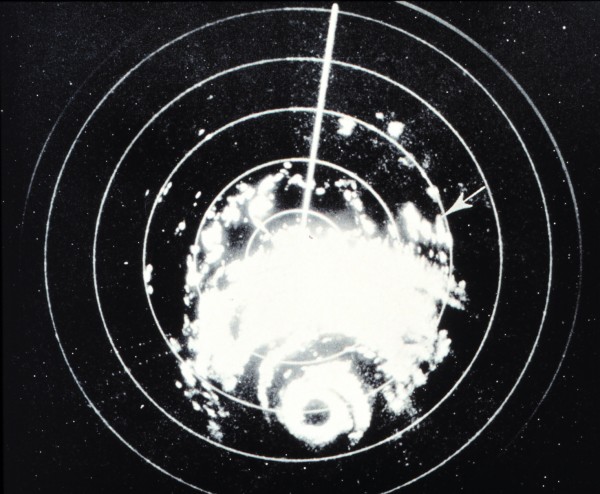Remembering Hurricane Carla (1961)
Radar image as Carla slowly approached the Texas coast on September 11, 1961
In September 1961, the memory of Hurricane Audrey was fresh in the minds of officials at the National Hurricane Center and along the Texas and Louisiana coasts. During Audrey in June 1957, the watches and warnings had been posted well in advance of the storm, but some of the calls to action had been ambiguous, their meaning lost in the uncertainty of forecasting a more unknown commodity back then. The result was that over 500 people perished along the low lying Louisiana coast.
The tropical storm that was Carla formed over the warm waters of the western Caribbean on Monday, September 4. The National Hurricane Center noticed the disturbance had a circulation and starting posting advisories on the newly formed tropical depression.
It received a name early on the following morning.
All day on the 5th, the storm plodded northwestward off the coast of Honduras and Nicaragua. On the afternoon of September 6th, Carla reached hurricane force, and was headed on a path toward the Yucatan Peninsula. The Hurricane Center began to warn interests in the Gulf to pay close attention to the latest advisories on Carla.
The newly formed hurricane deftly weaved right, then left, like a football runner in the open field avoiding a tacker, and successfully threaded the needle between Cancun and Cuba, avoiding land and continuing to strengthen. Carla would be in the Gulf and forecasters already were beginning to see signs that this one meant business.
At 4 p.m. on Thursday, September 7th, a hurricane watch was ordered along the Gulf Coast from Morgan City to Apalachicola. Careful not to repeat what had happened during Audrey, advisories strongly warned people along the coast on Friday the 8th that tides were already rising and escape routes would be cut off.
The watch was extended westward, first to include all of the Louisiana coast then by late morning, to include all of the Texas coast. Carla was a powerful category three hurricane then with top winds of 125 mph, some 600 miles southeast of Galveston, moving northwest at just 5 mph. The waiting game was one to see where Carla would finally pounce.
Meanwhile, the storm was growing in size as well. It covered nearly the entire Gulf of Mexico. By Friday general evacuation was in progress along the Texas and Louisiana coasts. Roads would be clogged all day Friday and Saturday as folks headed away from the coast in what was probably the greatest pass movement of any kind during peacetime.
By Sunday morning, towns all along the Louisiana and Texas coasts looked like ghost towns. As the eye of the storm came into view of ground based radars along the coast, it began to make an exasperating series of feints to the right and left as if to tease forecasters. As a rapt audience watched and listened, newsmen and weather people tried to predict Carla’s next move.
Meanwhile, tides were already five to six feet above normal along the coast, in a scene that would be eerily predictive of Hurricane Ike nearly half a century later. Forecasters were warning that tides would reach 10-15 feet above normal east of where the center made landfall. Then during the night came reports that the winds had increased further, to 150 mph. Carla was a monster.
Adding to the drama, the hurricane nearly stalled and began moving erratically through the morning hours, even describing a complete loop that delayed the arrival of the eye on the coast by over five hours. The slow and erratic movement combined with the huge size meant that people were in gale and hurricane force winds for long periods of time.
Finally, Carla made up her mind and moved ashore just to the west of Port O’Connor, Texas on Monday afternoon. September 11th.
At landfall, the central pressure in the storm was 931 millibars. The eyewall was 61 miles across. A storm surge of up to 19 feet was measured. Damage was heaviest in Port O’Connor and Port Lavaca where nearly all of the buildings were gutted.
Despite the storm’s tremendous size and power, only 46 deaths were attributed to Carla, a testament to the increasing value provided by the U.S. Weather Bureau, Civil Defense and the new medium of television in the early 1960s.
Category: Met 101/Weather History
















